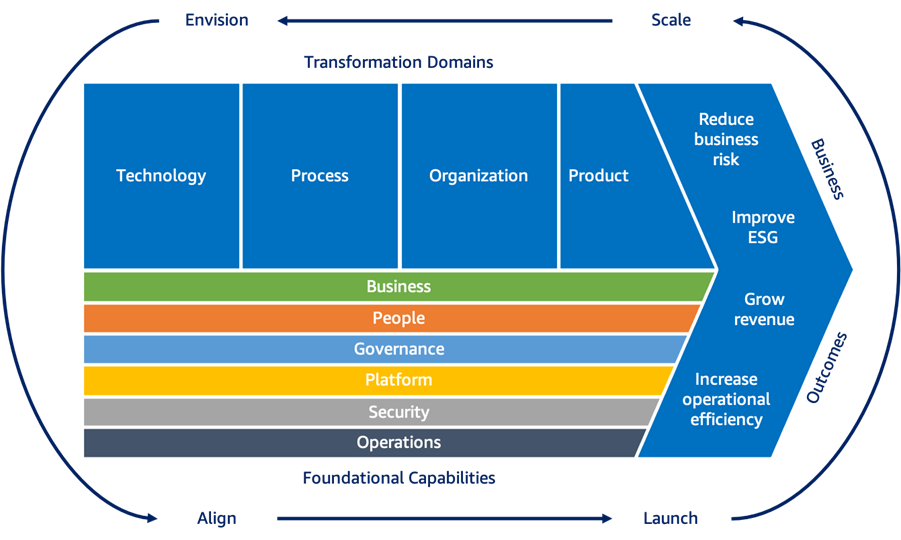Story
Now, let me take you on a journey through the story of Acme Corporation:
Acme Corporation, found itself facing numerous challenges. They were a traditional manufacturing company struggling to keep up with technological advancements and changing customer expectations and business demands. They knew they needed to find a way to reinvent themselves to stay competitive.
– However, without any guidance and structure Acme Corporation didn’t know they will face significant obstacles in their cloud journey. They experienced difficulties migrating their legacy systems to the cloud, leading to disruptions in their operations and increased costs. The opposite of their expectations!
– The absence of a systematic approach made it challenging for Acme Corporation to fully leverage the cloud’s potential. They struggled to optimize their processes, failing to harness the power of data analytics and real-time insights to drive informed decision-making.
– The lack of organizational alignment and collaboration further hindered their progress. Siloed departments and outdated communication practices slowed down their ability to innovate and respond to market changes.
In this series I’ll talk about AWS adoption framework, and will take it step by step in each blog towards achieving a successful cloudy journey.
Introduction
In today’s world with a rapidly evolving digital landscape, cloud adoption has become a key success driver for organizations that are seeking to stay competitive and innovative. As those organizations and businesses strive to unlock the full potential of the cloud, a structured and strategic approach is crucial to ensure a successful migration.
AWS Cloud Adoption Framework (AWS CAF) is a comprehensive guide designed to help you and your organizations confidently navigate the cloud adoption journey.
In this blog series, we will explore the AWS CAF and dive into its various components, starting with an introduction to the framework and an exploration of its value chain.
Understanding the AWS Cloud Adoption Framework (AWS CAF)
The AWS CAF is your go-to blueprint for planning, executing, and governing your cloud adoption strategies effectively. It is built upon a set of guiding principles, best practices, and a comprehensive framework that aligns business objectives with cloud adoption goals. By adopting the AWS CAF, organizations can mitigate risks, optimize costs, and accelerate their cloud journey.
One of the fundamental aspects of the AWS CAF is its value chain where technological transformation enables process transformation which enables organizational change that enables product transformation.


Cloud Transformation Value Chain
The Cloud Transformation Value Chain consists of various domains that drive the overall transformation process, including technological, process, organizational, and product transformations.
Technological Transformation Domain.
Focuses on leveraging the cloud to migrate and modernize legacy infrastructure, applications, and data and analytics platforms. By migrating to AWS, organizations can realize significant cost reductions, increased efficiency, decreased downtime, and improved security events.
Process Transformation Domain.
Organizations digitize, automate, and optimize their business operations using cloud capabilities. This includes harnessing data and analytics platforms to derive actionable insights and utilizing machine learning (ML) for enhanced customer service, employee productivity, decision-making, fraud detection, and more. Process transformation improves operational efficiency, reduces costs, and enhances the overall employee and customer experience.
Organizational Transformation Domain.
Revolves around reimagining the operating model by fostering collaboration between business and technology teams. Organizing teams around products and value streams, coupled with agile methodologies, enables organizations to be more responsive, customer-centric, and adaptable to change.
Product Transformation Domain.
Focuses on redefining the business model by creating new value propositions, products, services, and revenue models. By leveraging the cloud, organizations can accelerate time-to-market for new features and applications, increase code deployment frequency, and reduce the time required to deploy new code. This transformation empowers organizations to reach new customers and explore new market segments.
Final Words
By addressing these dimensions of the Cloud Transformation Value Chain, organizations can achieve great and impactful transformations, leading to increased operational efficiency, agility, cost savings, and improved customer experiences.
I suggest taking a look at these benchmark results https://mohammad-omar.com/Cloud-Value-Benchmarking
The AWS Cloud Adoption Framework provides organizations with a clear roadmap and a comprehensive set of resources to guide them through their cloud adoption journey.
Each of the transformation domains described in the preceding section is enabled by a set of foundational capabilities shown in the following figure.
In our next blog, we will dive into the foundational capabilities of the cloud adoption framework CAF.


